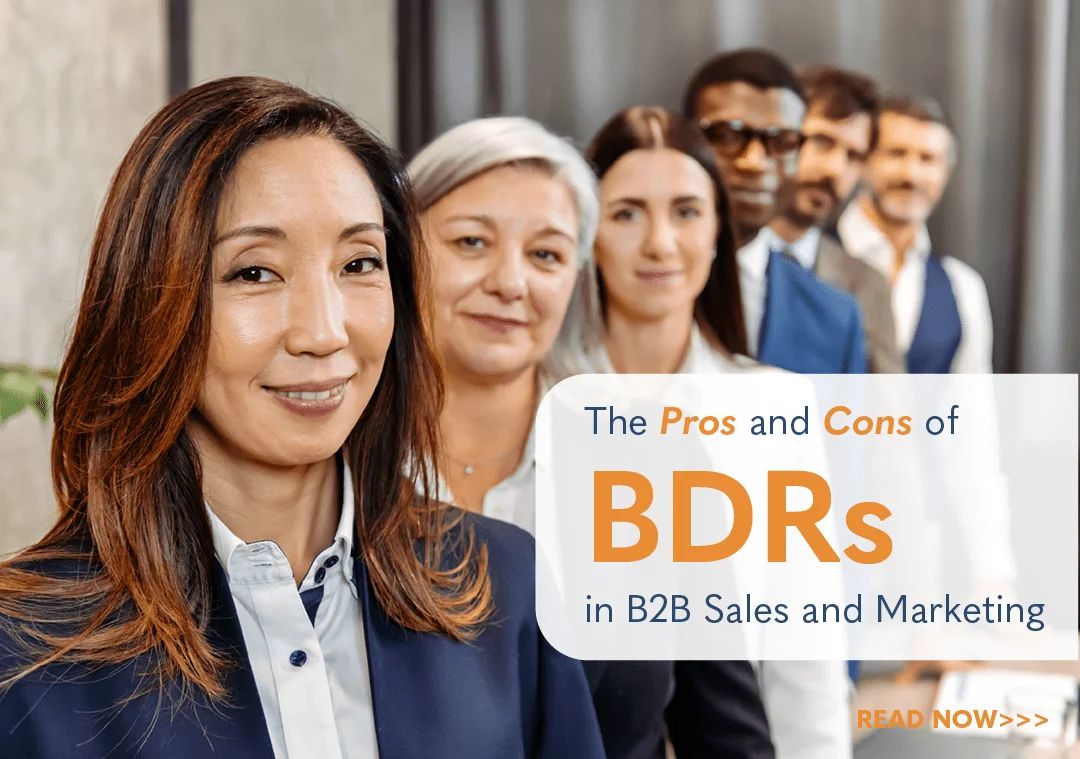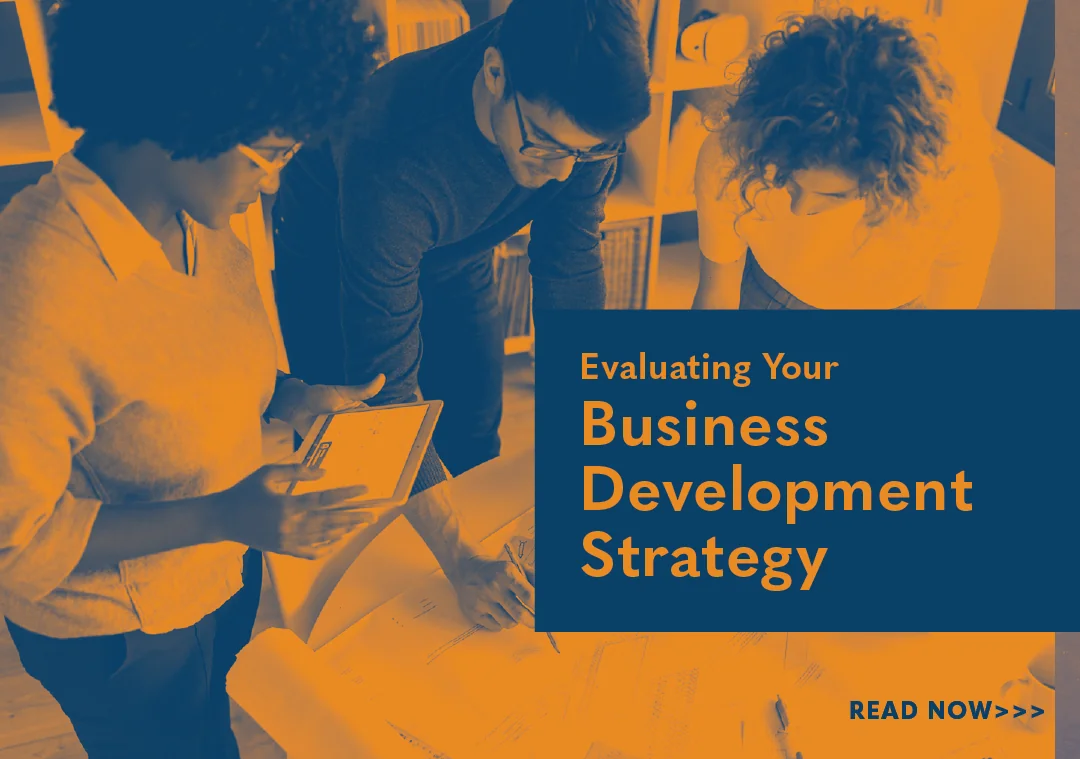The Pros and Cons of BDRs in B2B Sales and Marketing

In B2B sales and marketing, companies employ various strategies to drive growth and expand their client base. One such strategy involves the use of Business Development Representatives (BDRs). Typically, these professionals are tasked with identifying and qualifying potential leads and initiating contact with prospects.
Our recent webinar Turbocharging Business Development Strategies noted the importance of BDRs. They can be instrumental in accelerating revenue generation and fostering customer relationships. However, their effectiveness hinges on various factors. And they may not be right for all organizations. Here, we’ll explore the role of BDRs, the pros and cons, and best practices to utilize them effectively:
The Role of BDRs
Typically, BDR is an entry-level position in larger, more complex sales organizations. They are tasked with acquiring new business. Of course, roles vary based on the size, scope, and scale of the organization. However, generally, BDRs are responsible for the following:
- Qualifying leads
- Identifying and communicating with prospects
- Helping grow existing accounts
- Seeking new business opportunities
- Understanding the competition and market
- Reporting to salespeople and managers
- Promoting customer satisfaction and loyalty
BDRs by the Numbers
In their 2024 yearly study, data analytics provider 6sense examined the state of BDRs in the current market. In general, they note:
- 75% of BDR organizations have grown or maintained their size.
- 76% percent of BDRs report to sales over marketing.
- 85% percent focus on outbound activities.
- BDRs typically make 17 attempts per contact (distributed between social media, phone calls, and emails).
BDR achievement has remained steady. However, the report does note a downward trend in support:
- Quota attainment has been holding steady between 81 to 90%.
- Support is down (76% in 2022, 64% in 2023, and only 58% in 2024).
- Support is directly tied to quota attainment.
Pros of Using Business Development Representatives
There are many things to recommend BDRs as a plus for your business development strategy. Some of the top include:
Lead Generation and Qualification
- Prospect identification
- Lead qualification
Effective BDRs excel at identifying potential leads within target markets or industries. They then leverage research tools and market insights to pinpoint promising opportunities.
Through personalized outreach, BDRs can assess a prospect’s level of interest, budgetary constraints, and purchasing timeline. This also ensures sales resources are allocated efficiently.
Pipeline Development
- Generate interest
- Relationship building
- Pipeline expansion
BDRs are often a lead’s first contact with your organization. Thus, they are instrumental in generating interest. Further, guiding prospects through the early stages of the buyer’s journey makes them essential to brand perception.
In addition, BDRs play a crucial role in account growth by building and deepening relationships within existing accounts. Further, they can seek and establish connections with new contacts and introduce them to your products and services.
Through consistent follow-up and relationship-building activities, BDRs can expand sales pipelines. This is accomplished by uncovering additional opportunities and cross-selling/upselling to existing clients.
Resource Allocation
- BDRs free sellers to sell
- Cost savings
By handling lead generation and initial prospecting tasks, BDRs allow sales representatives to focus on high-value activities. These include conducting product demonstrations, negotiating contracts, and closing deals.
Utilizing BDRs can lead to cost savings. They can streamline the sales process and reduce the need for expensive lead generation tools or outsourcing services.
Market Insights and Feedback
- Customer intelligence
- Feedback loop
BDRs serve as frontline ambassadors for the company. Through their interactions, they gather valuable insights into customer preferences, pain points, and competitive landscapes.
In addition, BDRs relay customer feedback and market trends to internal teams. Thus, they facilitate continuous improvement in product development, marketing strategies, and customer service initiatives.
Scalability, Flexibility, and Growth
- Scalable model
- Adaptability
- Growth and retention
As businesses grow, BDR teams can be easily scaled up or down. This enables them to accommodate fluctuations in demand or expansion into new markets.
BDRs can readily adapt their approach based on evolving market dynamics, customer needs, and competitive pressures. This ensures ongoing relevance and effectiveness.
In addition, 2024 data by Numentum consultants show most BDRs prefer sales over marketing. In fact, 76% of those who report to sales want to stay there. However, marketing is different. Here, 47% of BDRs wanted to move to sales while 43% wanted to stay in marketing. These figures are important to gauge BDR growth and retention.
One reason may be marketing BDRs report less time prospecting. Perhaps, there’s not enough alignment with sales AEs. Instead, marketing BDRs devote more time to inbound lead qualification. Plus, sales BDRs attain quota more, by as much as 10%.
Cons of Using Business Development Representatives
While there is much to recommend BDRs in a business development strategy, they do come with some risk. For organizations considering adapting or continuing BDR programs, take note of the following:
Cost and Overhead
- Investment required
- Management overhead
Hiring and training BDRs incurs significant upfront costs in terms of recruitment, onboarding, and ongoing salary expenses.
Managing a BDR team entails additional overhead in supervision, coaching, and performance evaluation. These can strain resources.
Quality vs. Quantity and Burnout
- Quantity-focused metrics
- Risk of burnout
BDRs may be incentivized to prioritize quantity over quality, leading to a focus on volume-based metrics. This includes the number of calls or emails sent rather than the quality of interactions.
Pressured to meet quotas, BDRs may experience burnout or resort to overly aggressive tactics. This can damage relationships with prospects. In addition, according to the Sales Mastery Sales Performance Scorecard, the turnover rate for BDRs is 80%.
Alignment With Sales Teams
- Misalignment of goals
- Handoff challenges
Misalignment between BDRs and sales teams can lead to conflicts. This includes lead handoff criteria, territory ownership, and commission structures, which can undermine collaboration and cohesion.
Ineffective communication and handoff processes between BDRs and sales representatives can have negative consequences. These include leads falling through the cracks or delays in the sales cycle.
Limited Scope of Influence
- Surface-level engagement
- Lack of product expertise
Due to the transactional nature of their interactions, BDRs may struggle to establish meaningful connections with prospects. This can limit their ability to influence purchasing decisions.
BDRs may lack in-depth product knowledge and technical expertise. These may be required to address complex customer inquiries or objections effectively and result in missed opportunities.
Dependence on Outbound Tactics
- Sustainability
- Adaptability
To generate leads, BDRs primarily rely on outbound tactics, such as cold calling, email outreach, and LinkedIn prospecting. Over time, due to saturation or evolving buyer preferences, these may become less effective.
BDRs may struggle to pivot toward more inbound-focused strategies, such as content marketing or social selling. This could limit their ability to adapt to changing market dynamics.
Best Practices for Maximizing BDR Effectiveness
- Invest in training, coaching, and development
- Align sales and marketing efforts
- Emphasize quality over quantity
- Implement clear, realistic, and achievable performance goals
- Continuous improvement
Provide comprehensive sales training and coaching to equip BDRs with the skills, knowledge, and tools to succeed. These include sales techniques, product training, and communication skills. In addition, ensure BDRs are encouraged, equipped, and enabled to utilize AI.
Foster close collaboration between BDRs, sales teams, and marketing departments. This should ensure alignment of goals, messaging, and lead handoff processes.
Encourage BDRs to prioritize meaningful engagements and relationship-building activities over sheer volume. Thus, they should focus on the quality of interactions rather than sheer numbers.
Performance metrics and KPIs should be clear, realistic, and achievable. These should incentivize desired behaviors and outcomes, such as lead quality, conversion rates, and customer satisfaction scores.
Regularly review and refine BDR processes, strategies, and tactics. To drive continuous improvement and adaptation, this should be based on feedback, performance data, and market insights.
Conclusion
Utilizing BDRs can offer significant advantages for organizations seeking to drive growth and expand their client base. By leveraging BDRs in lead generation, relationship-building, and market insights, sales organizations can accelerate revenue generation. Additionally, they can optimize resource allocation and foster customer relationships.
However, it is essential to also recognize and address the potential pitfalls associated with BDR programs. These include the cost considerations, alignment issues, and sustainability concerns.
Through best practices and continuous improvement, sales organizations can maximize the effectiveness of BDRs and achieve long-term success. We hope this helps your organization make the best choice for your needs. For additional information, check out our webinar, Turbocharging Business Development Strategies.

- Account Planning (11)
- Awards (49)
- Client Testimonial (37)
- Personal Branding (19)
- Podcast (11)
- Research (70)
- Sales Career Development (87)
- Sales Coaching (156)
- Sales Consulting (137)
- Sales Culture (170)
- Sales Enablement (354)
- Sales Leadership (109)
- Sales Management (248)
- Sales Negotiation (16)
- Sales Prospecting (125)
- Sales Role-Playing (18)
- Sales Training (235)
- Selling Strategies (263)
- Soft Skills (70)
- Talent Management (94)
- Trusted Advisor (27)
- Virtual Selling (49)
- Webinar (9)


























